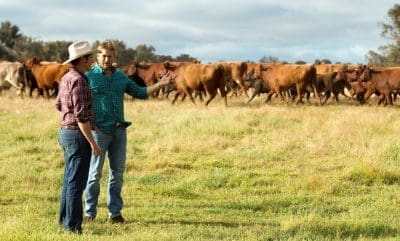Australian beef producers have indicated growing optimism in the Australian beef industry according to the latest Beef Producer Intentions Survey.
Conducted three times a year by Meat & Livestock Australia, the latest survey conducted in April reported that one in two producers saw a positive outlook, resulting in a net positive sentiment increase of 11pc to 34pc compared to the previous survey in November.

A much smaller cohort saw a negative outlook (16pc), while 31pc were uncommitted and uncertain about the next 12 months.
The latest survey spoke to more than 3000 grassfed beef cattle producers, covering producer sentiment and intentions, herd profile, spring and autumn calving, turn-off weights for different producer types and sales-to-date forecast.
MLA market information manager Stephen Bignell said northern producers were generally more positive than southern producers, but there were key variations across the states.
“The results suggest that Queensland, New South Wales and Victorian producers are more positive than producers in other states, mostly due to an increase in prices and increased confidence following rain over the summer,” Mr Bignell said.
Sixty two percent of northern producers noted the 2023-24 wet season (summer rainfall) had some, or a strong, influence on their more positive outlook.
Nationally, 55pc of producers who stated they had a more positive outlook since November put the change down to steady or improving cattle prices. Among those that said their sentiment had become more negative since November, 58pc blamed lower than expected cattle prices, 19pc due to higher cost of production and inputs, and 14pc due to government regulation including live sheep export ban and biosecurity levy.
Producers in Western Australia continue to report a far less positive outlook, driven by a fall in prices and a lack of rainfall in key cattle grazing areas.
At the producer level, there was a net intention to increase the on-farm grassfed adult beef cattle herd in the next 12 months:
- 28pc indicating they would increase their herd size
- 54pc indicating it would remain unchanged; and
- 19pc indicating they would decrease their herd size.
“We note this is a clear change in intention from that reported in the November survey where there was a stronger intention to reduce herd sizes, reflecting the dry conditions heading into summer,” Mr Bignell said.
“While the results do not indicate producers have all shifted to a rebuild focus, there has been a noticeable shift away from herd reductions at this stage.”
When analysed further, producers noted that the summer rainfall had influenced their herd size intentions.
The April survey had a focus on measuring some of the demographics of Australia’s herd.
From the survey it has been estimated that there are just over 26 million on-farm grassfed adult beef cattle on hand. Just more than half are breeding cows with heifers making up an additional 15pc of the total estimated herd size.
Queensland accounts for almost half the national herd size (48pc), with New South Wales holding 20pc and the remaining states making up the rest.
The Beef Producer Intentions Survey was designed by MLA to support the industry with reliable data and is used by MLA and the Australian Bureau of Statistics. It is one of the inputs into the MLA beef industry forecasting models.
MLA’s mid-year Industry Projections will be released during August, in order to gather-up data from the June quarter ABS data released in early July.
Other statistics to note
In terms of turnoff weights, 19pc of producers responding to the survey said their turnoff weights would be heavier than last year, with 67pc expecting no change and 12pc believing their turnoff weights would be lower.
StoneX livestock and commodities manager Ripley Atkinson, who was one of the architects of the new producer intention report while working earlier with MLA, said although only one in five expected to have heavier weights and seven in ten are expecting weights to be unchanged, with the productivity of the national herd increasing significantly, the heavier weights producers are achieving provided an early lead indicator to higher beef production when these animals are processed.
“The ABS Q2 and Q3 production data should reflect this,” he said.
The report said weaners on average are being turned off at 7.25 months of age at a weight of 306kg and feeder steer turnoff weight on average is 406kg.
“The average branding percentage for southern Australia’s spring calves was 84pc, 11pc higher than the average autumn branding percentage, which says drier seasonal conditions for the southern cow herd had an impact on branding through calf loss or abandonment,” Mr Atkinson said.
Click here to view the full survey
